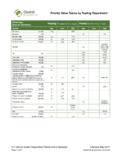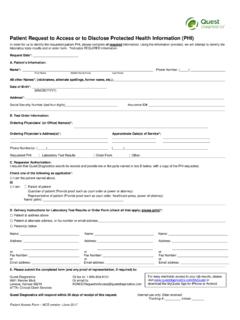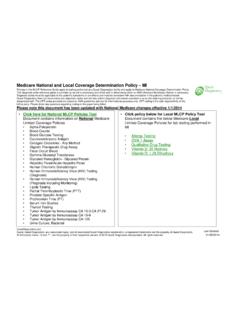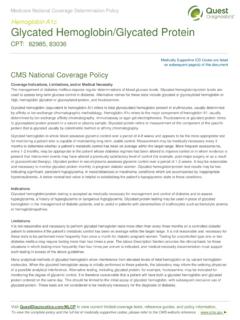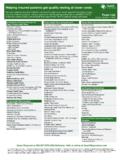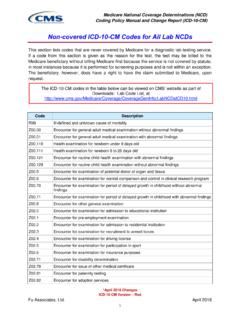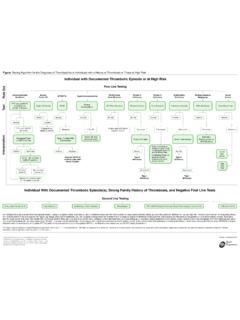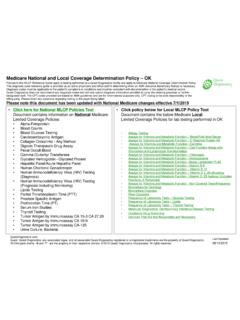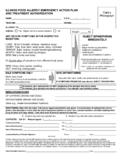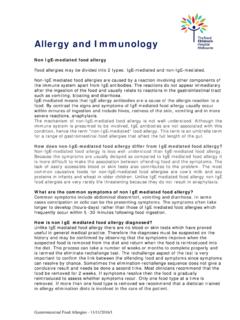Transcription of Allergies Across America: The Largest Study of Allergy ...
1 The Largest Study of Allergy Testing in the United StatesAllergies Across america Quest Diagnostics Health Trends Allergy Report 2011 Quest DiagnosticsThe Largest Study of Allergy testing in the United StatesI am pleased to present to you the first Quest Diagnostics Health Trends Allergy report, Allergies Across america . This report is the Largest analysis of Allergy testing of patients in the United States under evaluation for medical symptoms associated with are a major public health concern, affecting the healthcare system, employers, and, indeed, patients. By the time you finish reading this report, you may be surprised by the dynamic nature of Allergies in the United States.
2 We found evidence that allergen sensitization is increasing, and that the type of allergens affecting Americans evolved during the 4 years we examined. We also found that allergens have a disproportionate negative effect on children. A novel finding is that men experience higher rates of sensitization to allergens than women. Even the way Allergies are diagnosed is changing, with a clear shift towards greater Allergy testing by pediatricians and other primary care physicians. We found evidence supporting the pattern of Allergy progression known as the Allergy march, in which allergen sensitization often evolves from food to environmental allergens.
3 Our analysis identified a connection between Allergies and asthma, building on prior research, but using our much larger data set. In addition, we revealed disparities in our healthcare system that should be cause for alarm for any policy maker, physician, or parent. Our Allergy report adds to our collection of Quest Diagnostics Health Trends reports developed in recent years on health concerns affecting large numbers of patients in the United States. Based on analyses of our national database consisting of more than billion patient encounters since January 2000 previous reports have focused on chronic kidney disease, diabetes, heart disease, H1N1 (2009) Influenza A, and rotavirus.
4 I encourage you to read these reports, which can be found at With mounting demands on our healthcare system, our nation must devise new, innovative methods of providing high quality services. Greater knowledge of the patient impact and clinical management of chronic diseases, such as Allergies , will be increasingly vital to the ability of healthcare professionals to deliver the best possible regards, Surya N. Mohapatra, and Chief Executive OfficerQuest A PDF of this report and additional content about Allergies and IgE testing are available at Health Trends Allergy Report 20113 Health TrendsAllergy Report 2011 Table of Contents SUMMARY 4 AboUT Allergies 7 Allergies and Their Symptoms 7 Impact of Allergies 7 Diagnosing Allergies 8 Treating Allergies 9 The Allergy March 10 america S Allergy PRobleM 12 Allergies are Increasing 12 Ragweed and Mold Increasing the Fastest 13 Worst Cities for Allergies 16genDeR: DoeS iT MAke A DiffeRence?
5 19 HigH iMPAcT of Allergies on cHilDRen 21 THe Allergy MARcH 24 Food Allergies in Children 24 Evolution from Food to Environmental Allergens 27link beTween Allergies AnD ASTHMA 28 DiSADvAnTAgeD cHilDRen: DelAYeD DiAgnoSiS 30cHAnging PHYSiciAn TeSTing PATTeRnS 32 Primary Care Physicians Play a Larger Role in Diagnosing Allergies 32 Adoption of Blood-Based Allergy Testing Varies by Region 33 ReSeARcH MeTHoDologY 35conTRibUToRS 37 RefeRenceS 38 LEARN MORE: Double click the tables or figures to view an enlarged Diagnostics4 The Quest Diagnostics Health Trends Report studies the effect of Allergies on a uniquely massive scale. It represents people Across the United States using a highly respected and standardized laboratory methodology.
6 Andrew H. liu, Associate Professor Allergy and Clinical Immunology National Jewish Health Denver, ColoradoHealth TrendsAllergy Report 2011 SUMMARYA llergies are one of the most common health conditions, affecting 1 in 5 Americans. Allergies account for more than 17 million physician office visits, 30,000 emergency room visits, and several hundred deaths each Individuals with Allergies are at heightened risk for other diseases, including asthma. As the world s leading diagnostic testing company, Quest Diagnostics is uniquely positioned to analyze the Largest national database of Allergy blood tests and derive insights into the impact of Allergies on the health of Americans.
7 For this Quest Diagnostics Health Trends report, we analyzed de-identified test results from more than 2 million patient encounters over a 4-year period. Our analysis included results from patients of both genders, from infants to the elderly, residing in every state and the District of Columbia. Allergies are clinically diagnosed based on factors that include medical examination, patient history, laboratory testing, and, as appropriate, allergen exposure testing. Our Study is based on testing using the ImmunoCAP specific immunoglobulin E (IgE) blood test (ImmunoCAP), the gold standard of Allergy blood ,3 Each test result identified sensitization to 1 or more of 11 common allergens.
8 Sensitization refers to a test result that indicates a patient has an allergen-specific IgE, which is important for diagnosing an Allergy but may not by itself be sufficient to prompt symptoms. The allergens we evaluated were 5 foods (egg white, milk, peanut, soybean, and wheat), common ragweed, mold, 2 types of house dust mites, cat epithelia (skin), and dog dander. Our Study is the Largest Study of laboratory test results from a nationally representative population seeking medical care for symptoms associated with Allergies . In addition to size, our Study s advantages include the use of validated quantitative laboratory test results of Allergy sensitization, rather than survey responses from physicians or patients.
9 As the vast majority of the patients in our Study likely presented with new or changing Allergy signs and symptoms, our analysis does not measure the prevalence of Allergies in the general findings include: america s Allergy problem is increasing. Our analysis found that the overall allergen-sensitization rate increased by over the 4-year Study period. In addition, the number of patients tested for these 11 allergens increased 19%, significantly faster than growth in laboratory testing in general (see page 12).5 Health TrendsAllergy Report 2011 Quest Diagnostics Sensitization to 2 common environmental allergens is increasing, consistent with prior climate change research.
10 Sensitization to common ragweed grew 15% more than any other allergen we analyzed with the Southwest, Mountain, and Plains States experiencing the highest sensitization rates. These findings are consistent with other research suggesting climate change may contribute to an increase in certain environmental allergens, such as ragweed. Mold sensitization grew 12%, a finding that is potentially clinically important given other research showing that molds may trigger allergic sensitization and aggravate asthma (see page 13). Allergies are prevalent throughout the , occurring in each of the country s 30 Largest cities. Yet, some cities demonstrated higher rates of sensitization than others, with Dallas, Phoenix, Baltimore, Washington, , and Boston experiencing the greatest burden (see page 16).
